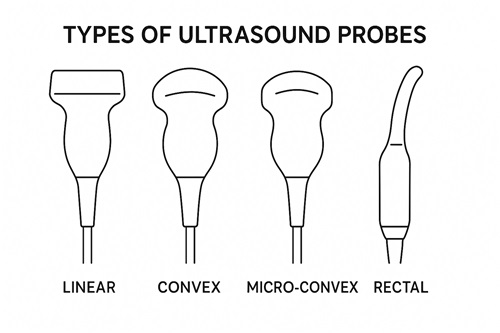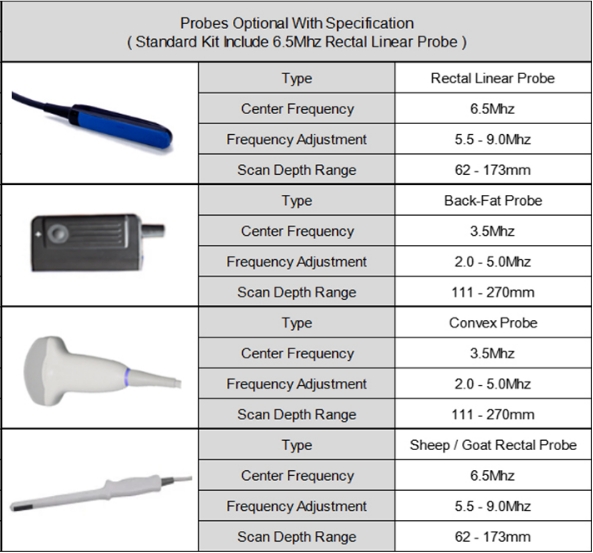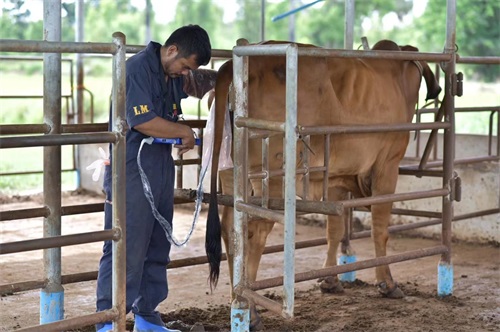Veterinary ultrasound is an essential diagnostic tool on farms and in clinics. Whether you’re raising cattle, 돼지, 말, 양, or even camels, ultrasound machines help monitor animal health, diagnose pregnancies, detect injuries, and evaluate internal organs. But one critical aspect that often gets overlooked is the frequency of the ultrasound probe. Understanding probe frequency can dramatically impact image quality and diagnostic accuracy. Let’s dive deep into what it means and how to choose the right one.

VET-ULTRASOUND PROBES
What is Ultrasound Frequency?
Ultrasound frequency refers to the number of sound wave cycles emitted by the probe per second, measured in megahertz (메가 헤르츠). In simple terms:
- Low frequency = Deeper penetration, but lower image resolution.
- High frequency = Higher image resolution, but shallower penetration.
In veterinary applications, probe frequencies usually range between 2.5 MHz and 12 메가 헤르츠. Choosing the right frequency depends heavily on the species, the animal’s size, and the area of the body being scanned.
Why Does Frequency Matter in Veterinary Practice?
In farm settings, different animals present different challenges:
- Cattle and Camels: These large animals have thick body walls, so low-frequency probes (2.5 – 5 메가 헤르츠) are preferred for deeper penetration to reach internal organs.
- Pigs: Pigs have thick skin and fat layers. Lower frequencies like 3.5 MHz work well for general scanning, but higher frequencies (7.5 메가 헤르츠) are used for detailed imaging, like fetal viability.
- 말: For musculoskeletal evaluations (tendons and ligaments), a high-frequency probe (7.5 – 12 메가 헤르츠) is best to see fine details.
- Sheep and Goats: These smaller ruminants benefit from mid-range frequencies (5 – 7.5 메가 헤르츠) that balance penetration and resolution.
Matching the right frequency with the species and diagnostic purpose ensures more accurate results and avoids misdiagnoses.
Types of Probes and Their Frequency Ranges
Different types of ultrasound probes (also called transducers) are used in veterinary medicine, and each type is associated with specific frequency ranges:
- Convex Probe (Curved Array): Typically operates between 2.5 – 5 메가 헤르츠. Ideal for deep abdominal scans in large animals like cattle.
- Linear Probe: High frequency, 7.5 – 12 메가 헤르츠. Perfect for tendons, superficial structures, and small animal imaging.
- Micro-Convex Probe: Mid-frequency, around 5 – 8 메가 헤르츠. Good for smaller farm animals and transrectal scans.
- Phased Array Probe: Lower frequency, compact footprint, excellent for cardiac scans, especially in larger species.
Choosing the correct probe type and frequency is crucial for achieving clear, diagnostic-quality images.

BXL Veterinary Ultrasound Probe
Practical Examples of Probe Frequency in Farm Settings
Let’s look at some real-world examples from farm life:
- 임신 감지 in Cattle: A convex probe operating at 3.5 MHz provides the depth needed to locate and assess the fetus.
- Lameness Check in Horses: When evaluating a horse’s tendon injury, a linear probe at 10 MHz offers the high-resolution detail required to spot minor lesions.
- Pregnancy Diagnosis in Pigs: For sows, a convex probe at 5 MHz can detect pregnancy reliably from about 25 번식 후 일수.
- Abdominal Scans in Sheep: Micro-convex probes operating around 6.5 MHz offer the best compromise for depth and detail in sheep.
The frequency choice impacts not just image clarity but also how quickly and accurately you can make management decisions.
How BXL Veterinary Ultrasound Helps
At BXL, we understand that different farm animals and situations require different probe frequencies. Our veterinary ultrasound machines, like the BXL-V50 시리즈, come with multi-frequency probes that allow users to switch between settings for optimal image quality.
- Adjustable Frequency Options: Tailor the frequency based on the animal and scanning target.
- Durable and Waterproof Designs: Built to withstand the rigors of farm life.
- Easy to Use: Designed with veterinarians and farm operators in mind.
Whether you’re checking the pregnancy of your champion mare or diagnosing respiratory conditions in young calves, BXL has you covered.

Final Thoughts
Understanding the frequency of veterinary ultrasound probes isn’t just technical trivia. It directly affects the success of your farm operations by enabling faster, more accurate diagnoses. Choosing the right frequency for the right animal and situation saves time, reduces stress for the animals, and ultimately improves productivity.
If you’re setting up or upgrading your farm’s veterinary imaging equipment, make sure to prioritize probe frequency alongside other features. And of course, if you want reliable, farm-tested machines, check out BXL’s full lineup of veterinary ultrasound solutions!